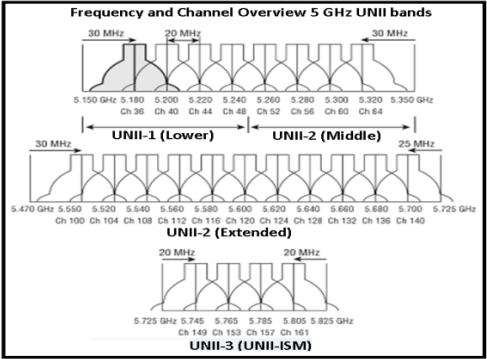Tags
Here is the CWAP Official Study Guide Chapter 1 (802.11 Overview) summary notes.
IEEE 802.11-2007 standard define communication mechanism only at Physical layer & MAC sublayer of the Data Link layer of the OSI model.
Layer 7: Application
Layer 6: Presentation
Layer 5: Session
Layer 4: Transport
Layer 3: Network
Layer 2: Data Link
— LLC (Logical Link Control) sublayer : MSDU–MAC Service Data Unit
— MAC (Media Access Control) sublayer : MPDU– MAC Protocol Data Unit
Layer 1: Physical
— PLCP (Physical Layer Convergence Procedure) : PPDU (PLCP Protocol Data Unit)
— PMD(Physical Medium Dependent) sublayer: modulated bits
PSDU (PLCP Service Data Unit) & MPDU refers the same & PSDU term used at PHY layer where as MPDU term used at the MAC layer.
802.11 frame contains a layer 2 MAC header, variable length frame body (0- 2304 bytes) & 32-bit FCS (Frame Check Sequence). A general 802.11 frame format is shown below (source: IEEE-802.11-2012)
 Below diagram shows the upper layer information moving between the Data-Link & Physical layers (source : CWAP Official Study Guide – Page 7)
Below diagram shows the upper layer information moving between the Data-Link & Physical layers (source : CWAP Official Study Guide – Page 7)
 IEEE 802.11-2007 Standard defines two major categories of 802.11 services called “station service” & “distribution system service“.
IEEE 802.11-2007 Standard defines two major categories of 802.11 services called “station service” & “distribution system service“.
Station Service (SS) :
Station Service is used by all 802.11 client stations including APs (APs have STA functionality). SS includes the following
1. Authentication
2. Deauthentication
3. Data Confidentiality (Encryption)
4. MSDU Delivery
5. Dynamic Frequency Selection (DFS)
6. Transmit Power Control (TPC)
7. Higher-layer timer sysnchronization (QoS facility only)
8. QoS traffic scheduling (QoS facility only)
Distribution System Service (DSS):
DSS is comprised of MAC sublayer services that are provided by the distribution system. DSS could be a WLC or AP depend on the way DS implement by a vendor. The DSS provides the following
1. Association
2. Reassociation
3. Disassociation
4. Distribution
5. Integration
6. QoS traffic scheduling (QoS facility only)
IEEE 802.11 standard defines 3 major frames types as shown below.
1. 12 x Management Frames (MMPDU – Management MPDU): Carry No MSDU
2. 8 x Control Frames – assist delivery of data frames, carry No MSDU
3. 15 x Data Frames – some with MSDU, some without MSDU, Null frame to inform AP about client power save status.
 IEEE 802.11-2007 standard includes (802.11 prime, 802.11b,802.11a,802.11g, 802.11h, 802.11i. 802.11j, 802.11e). Here is a brief summary of 802.11 PHY & MAC standard development over the years.
IEEE 802.11-2007 standard includes (802.11 prime, 802.11b,802.11a,802.11g, 802.11h, 802.11i. 802.11j, 802.11e). Here is a brief summary of 802.11 PHY & MAC standard development over the years.
 *HR-DSSS – High Rate Direct Sequence Spread Sprectum
*HR-DSSS – High Rate Direct Sequence Spread Sprectum
** OFDM – Orthogonal Frequency Division Multiplexing
** ERP- Extended Rate Physical
Below shows the 802.11b/g (2.4GHz) & 802.11a (5GHz) channels (sourcing from below CiscoLive Presentation. Here is the link to watch recorded session)
BRKEWN-2017 -Understanding RF Fundamentals and the Radio Design of Wireless Networks
Below shows the 802.11n & 802.11ac data rates values (sourcing from the same presentation)

 WiFi Alliance (Originally named WECA– Wireless Ethernet Compatibility Alliance)
WiFi Alliance (Originally named WECA– Wireless Ethernet Compatibility Alliance)
It’s main task is to ensure the interoperability of WLAN products by providing certification testing. Wi-Fi Certified program includes the following
1. 802.11 baseline
2. Wi-Fi Certified n
3. Wi-Fi Protected Access (WPA/WPA2)
4. Wi-Fi Protected Setup (WPS)
5. Wi-Fi Multimedia (WMM)
6. WMM Power Save (WMM-PS)
7. Converged Wireless Group- RF Profile (CWG-RF)
8. Voice Personal
9. Voice Enterprise
References
1. CWAP Official Study Guide – Chapter 1


